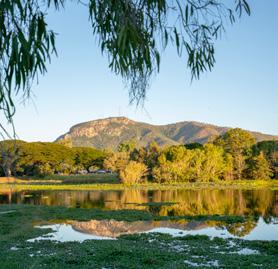
3 minute read
Principles of the liveability strategy
Liveability outcomes
Townsville liveability strengths
Liveability strengths are the attributes that the community value most and the city performs well in. These strengths are outcomes that Townsville needs to celebrate, encourage, support and share benefit from.
NATURAL ENVIRONMENT
The Townsville community celebrates and values the unique elements of our natural environment. Townsville provides a laid-back tropical lifestyle that is complemented by capital city comforts. Townsville is located about halfway between the tip of Cape York and Brisbane and boasts a stunning natural environment. The Ross River flows from the foothills of the Hervey and Mount Stuart ranges to its outlet in Cleveland Bay, where the CBD’s skyline is dominated by the distinctive Castle Hill and Magnetic Island lies just eight kilometres offshore.
Goal: Celebrate, encourage, maximise and share in the benefits of the natural environment elements that make Townsville a unique and beautiful place to live.
2.
LOCAL BUSINESSES
Locally owned and operated businesses are valued by Townsville residents. Local businesses that provide for our everyday essentials and daily needs are valued most and perform well in local communities. Goal: Celebrate, encourage, support and share benefit from our locally owned and operated businesses.
3.
ACCESS TO LOCAL SHOPS AND SERVICES
Having a high level of access to local amenities is an asset for Townsville and highly valued by Townsville residents. Access to amenities such as local shops, cafes, restaurants, health and wellness services, and civic services is important to the liveability of communities. Goal: Celebrate, encourage, support and share benefit from having great access to local shops and services within neighbourhoods.
Liveability outcomes
Townsville liveability challenges
Our liveability challenges are the attributes that are highly valued by our community but are currently underperforming. These challenges are liveability improvement priorities for Townsville. It is through focusing and aligning works, programs and projects to improve these outcomes that we can achieve our greatest return on investment and improve the overall liveability of Townsville.
4.
SENSE OF SAFETY
In the hierarchy of needs, safety is a basic need and essential factor for wellbeing. This is also applied in terms of place and liveability6. A sense of safety in liveability is related to both personal safety as well as neighbourhood safety from crime, traffic and pollution. The perception of being safe is also often unrelated to actual incidence of crime or hazard risk but is more directly influenced by a range of factors including gender, age, ethnicity, prior victimising and socio-economic status. Other influencing factors include media, neighbourhood environment (litter, vandalism and poor lighting), lack of neighbourhood cohesion (lack of diversity and inclusion in communities) and specific location triggers (shopping centres, public spaces with young people, public drunkenness etc).7 An improved sense of safety can be achieved by reducing the negative impacts of crime, traffic and pollution, as well as the maintenance and activation of public spaces, improving social cohesion and social connections in local neighbourhoods. Goal: To improve the sense of safety for the community in terms of personal safety and neighbourhood safety through influencing factors such as media, local environment, maintenance and activation of public places, community cohesion and inclusion.

5.
CONDITION AND QUALITY OF PUBLIC SPACES
The condition and quality of public spaces is a highly valued liveability attribute for the Townville community. It includes open spaces like parks as well as assets such as streets, street trees, landscaping and public footpaths. This typically ‘green infrastructure’ is of critical value to a city’s well-functioning infrastructure network. Trees in the urban landscape have innumerable benefits including public health, reducing heat, combating climate change, stormwater management, biodiversity and supporting enjoyable, safe and healthy communities.8 Good quality public spaces not only reflect a well-functioning city, but a well-cared for city that is loved by its residents. Goal: To prioritise the delivery of quality public spaces and continuously improve the condition of public spaces, with focus on providing for and valuing our city’s green infrastructure.




